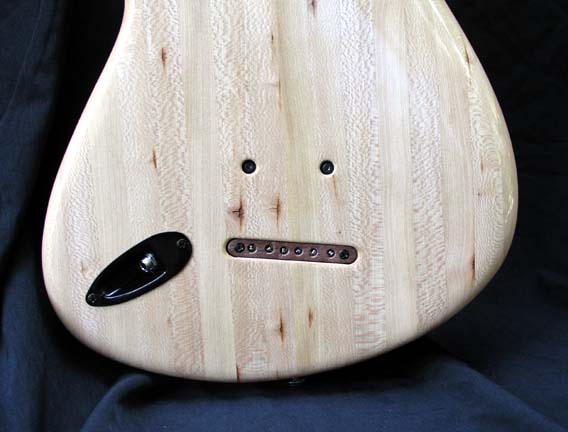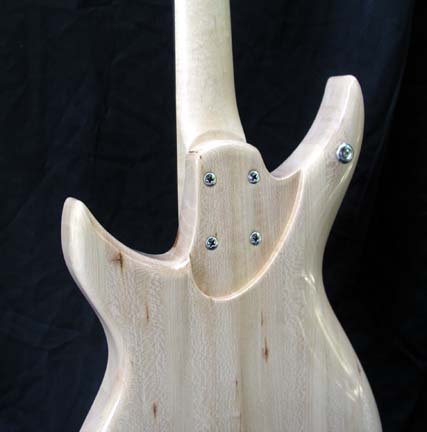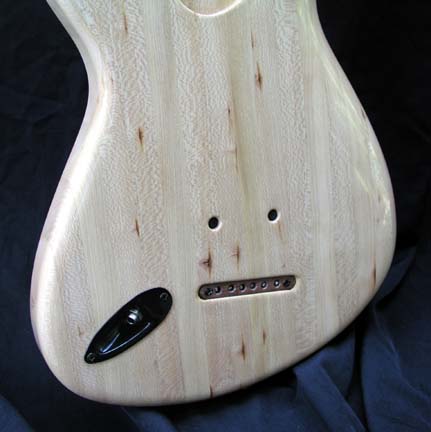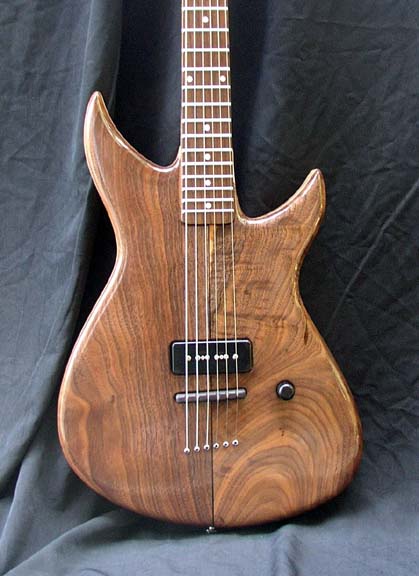




click image for a larger look
The Del Fuego design is one I've not visited sincethis previous Del Fuego. My intent was a design with a touch of aggression... something that might be played by a bar band in a Tarantino or Rodriguez horror film.
As most viewers of my guitars will perhaps have surmised by now, I'm partial to asymmetrical designs with offset waist curves and horns. The Del Fuego - if I remember correctly - is also the same as my favorite design, the DonnaKay, from the waist down. It translated well onto a guitar with a bit more bite than the DonnaKay.
This particular guitar began as a conceptual project, to work out the details of a wooden bridge, which was originally a floater, like on a jazz guitar. I've played archtops for years and love the floating bridges of those guitars. Other than not being bulletproof, I couldn't think of a reason not to use one on a solid or semi-hollow guitar.
I decided to make the bridge height-adjustable, using threaded inserts and allen screws, which can be adjusted from behind with an allen wrench. It's extremely convenient, especially for a slide player, who prefers a higher action so as not to knock the frets with the slide.


click image for a larger look

I set the intonation for stringsets with a .011 high-E and haven't checked it with any other gauge. It shouldn't be off too far using other gauges, but a new bridge certainly could be easily built to compensate for different strings.

click image for a larger look
Besides wooden bridges, another of my fascinations this year has been single pickup configurations, like a jazz box with a single neck pickup or the classic Les Paul Jr., one of the most popular guitars in history. The LP Jr. uses a single P90, just as this Del Fuego does, in the bridge position. I chose to further simplify the tableau by only including a volume control without a tone control. I'm quite pleased with the richness of the tone from this guitar. I was expecting it to be a bit more trebly, but the wooden bridge may be keeping those obnoxious, ear-bleeding frequencies at bay. That's pure speculation on my part, however. I've no scientific proof, but the guitar does indeed sound rich and full. Some folks will miss a tone knob, but if you play with a Crybaby or other wah-wah pedal, you've already got a tone control to use in your arsenal. I just like the simplicity of guitars like this.

click image for a larger look

click image for a larger look
The maple neck of this guitar is of Korean origin - a new one I had laying around the shop for awhile. Deciding it would make a great demo neck for my concept guitar, I altered the headstock shape to better suit my Del Fuego design and refinished it completely with a hand-rubbed Tru-oil finish - the hands-down preference of guitarists everywhere - for a super smooth play. I also levelled and polished the frets just to make sure everything was in order. Although I prefer a wider and thicker neck, this one is typical by Fender standards, so most everyone will enjoy playing it. Under the cloudy, thick urethane finish that I removed was a bit of interesting, lacy maple figure, too.

The body is semi-hollow, meaning, there's a block running down the center, but the sides are completely hollow. On this particular guitar, the block only runs past the string-throughs about 3/4", so it's hollow all across the lower region, as well. The top wood is, of course, walnut with a thin dividing line of black-dyed maple between the two halves. The back wood is a local sycamore that I laminated for stability. Each of these woods sound great when tapped and I'm extremely pleased at the way this guitar sounds, acoustically speaking.


I love wood that exibits its inherent unique characteristics. The brownish discolorations in the sycamore are simply mineral stains or naturally occurring variations in the wood. They're not in any way a structural flaw, though some people prefer a more "pristine" nature to their wooden instruments. Since these discolorations are natural, I think they add an amount of individuality to a piece and give it a simple honesty, whereas consistent figure or a lack of variation sometimes tends to look contrived or even artificial. Wood is an amazing material and I like to celebrate its unique character by using some unique examples in my guitars.
Let me say a word about the finish. This Del Fuego is finished using my favorite finish of all time: Tru-oil - not really an oil at all, but a fine grade of varnish that I apply by wiping on with a cloth in numerous applications. The number of coats can vary from 5 or 6 to 20-25, depending on several factors. This is an extremely thin finish, which allows the wood to shine through in all its glory, some would say acoustically, as well. If you've ever seen the finish on a fine violin, you'll know just how thin these wiped on varnish finishes can be, which, on an acoustic instrument, allows the wood to do what it does best acoustically, without being retarded by a thick finish. A hand-applied Tru-oil finish has a certain amount of warmth to it that I prefer, as well. As it ages, it shrinks further still to reveal a bit of the texture of the wood, much like very old guitars with nitrocellulose lacquer finishes or fine violins with a few coats of varnish.

click image for a larger look

click image for a larger look
On this particular instrument, I've chosen to let the finish remain glossy, though I sometimes will buff or rub it down to have a very even satiny finish that feels amazingly smooth. It makes an instrument so very inviting to the touch and feels as familiar as a lover's skin. Not that I have anything against lacquer finishes, because I also finish some of my instruments that way, but I truly prefer the rubbed Tru-oil finish for guitars that I play again and again. These guitars also seem to have that sort of vintage feel right off the bat, rather than waiting for years for the finish to shrink or get worn away. It just feels more like being in direct contact with the wood, than does a thicker lacquer finish.

click image for a larger look
Remember, this is a handcrafted guitar, built to be played. Handcrafted custom guitars have a personality and warmth that has to be experienced by the player or afficianado to truly be appreciated. There are parts of the process that I could perform faster with specific router bits or sprayers, but those don't yield the type of instrument I'm after. That's not to say there's anything wrong with those other types of instruments, because different hands fit different hammers. It's all about personal decisions and what it means to an individual. Some folks prefer a weekend partying in Vegas and others prefer a quiet weekend in the great outdoors. Both valid, but completely different animals.
One other unique feature on this guitar that I'd like to point out: under the walnut insert in back through which the strings are threaded is a brass plate with a ground wire soldered to it from the output jack. Using a wooden bridge, I needed a method to ground the strings as per common practice and the brass plate does double duty as a through-body tailpiece and ground plate.



click image for a larger look

This guitar is signed and dated in the neck pocket and pickup cavity. Which reminds me, the pickup is not mounted on a foam pad or with springs. It's directly mounted to the wood of the center block of the guitar to eek out every last drop of tone from the instrument possible. Many prefer this feature as it also eliminates any excess vibration that can have a possible negative effect on sustain.
Specifications
Body: semi-hollow sycamore with walnut top
Neck: commercially-made Asian neck, originally a Fender-style replacement
Nut: 1 11/16"
Scale: 25 1/2" Fender scale
Fretboard: rosewood, 21 frets
Pickups: Mighty Mite P90 - a truly underrated pickup
Switching: volume only
Bridge: solid ebony, compensated and intonated, height-adjustable
Tuners: chrome six-in-line.
Finish: hand-rubbed Tru-oil
